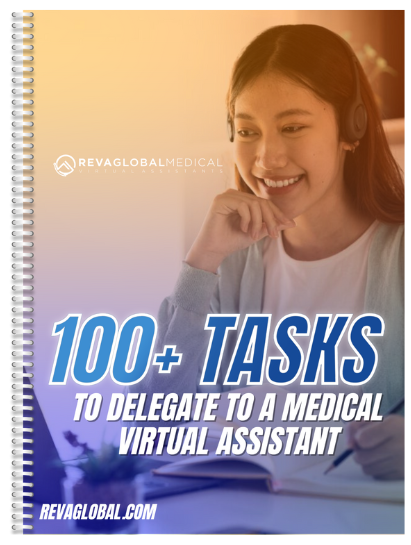The Smartest Hire Doctors Are Making Right Now: Medical Virtual Assistants

As a doctor, what is it that takes your time the most?
Chances are, it’s not the part of your day spent face-to-face with patients. It’s everything else. The endless documentation. The back-and-forth phone calls. The scheduling conflicts. The EHR that eats up more time than it saves. The stack of insurance claims waiting for review. The inbox full of patient messages that you’re too tired to answer at 9 p.m. but can’t ignore.
Sound familiar?
You’re not alone.
In today’s healthcare landscape, the administrative burden placed on physicians is staggering—and growing. A study from the Annals of Internal Medicine found that doctors spend nearly two hours on administrative tasks for every one hour of direct patient care. That’s two-thirds of your day lost to work that doesn’t require a medical degree, but still lands squarely on your shoulders.
And the effects are real: long hours, late nights, burnout, and less time doing what you actually trained for—caring for patients.
So the real question is: How long are you going to keep trying to do it all alone?
The Administrative Overload Is No Longer Sustainable
Whether you run a private practice or work within a larger healthcare system, the pressure to juggle patient care and operations is intense. You’re expected to be a doctor, office manager, customer service rep, insurance liaison, and tech support—all at once.
The average physician now spends over 15 hours per week on paperwork alone. Add in scheduling issues, insurance pre-authorizations, patient follow-ups, lab coordination, and EHR maintenance, and suddenly your day is full before you even see your first patient.
What’s worse? Many of these tasks are necessary—but they’re not what you went to medical school for. They don’t fulfill you. They don’t improve patient outcomes. And they’re slowly chipping away at your ability to run an efficient, thriving practice.
And Let’s Talk Burnout
Physician burnout isn’t just a buzzword—it’s a crisis. According to the American Medical Association, more than 63% of physicians report at least one symptom of burnout. Time pressure and documentation burden are among the top contributors.
You feel like you’re constantly behind. You’re working longer hours, yet the quality of patient interactions is declining. Your evenings are spent catching up on notes or answering non-urgent messages. Weekends? Those are for catching up on billing and insurance claims.
At some point, something has to give.
And for many physicians, the solution is becoming clear: hire a Medical Virtual Assistant.
Medical Virtual Assistant (MVA): Your Behind-the-Scenes Lifesaver
If you’ve never worked with a Medical Virtual Assistant before, think of them as your remote right-hand—someone who works outside your office, often from another country, but is fully integrated into your daily operations.
An MVA is a trained professional who specializes in supporting medical practices like yours with the very tasks that consume your time, drain your energy, and slow your workflow.
What Can an MVA Do for You?
Here’s how doctors are using MVAs right now:
-
Appointment Scheduling & Calendar Management: Eliminate double-bookings and reduce patient no-shows.
-
Inbox & Patient Messaging: Triage incoming messages, manage prescription refills, and handle routine patient inquiries.
-
EHR Support & Chart Preparation: Pre-fill charts, summarize previous visits, and save you hours on documentation.
-
Medical Billing & Claims Follow-Up: Track unpaid claims, resolve denials, and communicate with insurance companies.
-
Prior Authorizations & Referrals: Get through red tape without disrupting your patient flow.
-
Patient Onboarding & Outreach: Make sure new and existing patients feel supported and heard.
All without adding another desk or overhead expense to your office.
The Results Speak for Themselves
Time is Money (Especially Yours)
If your billable rate is $300/hour, and you spend even 10 hours a week on administrative work that an MVA can handle for $12–$15/hour, that’s $3,000/week in lost revenue opportunity. Even reclaiming half that time means your MVA pays for themselves many times over.
Improved Patient Experience
Doctors who integrate MVAs often report smoother workflows and more satisfied patients. When you and your in-office team aren’t bogged down by backend tasks, your patients get more focused, compassionate care.
Greater Accuracy & Less Stress
MVAs are trained in medical systems and processes. They use checklists, follow SOPs, and bring consistency to your daily operations. That means fewer dropped balls, fewer errors, and less stress for you and your staff.
“But Will They Understand My Practice?”
Yes. Because this isn’t about hiring a general virtual assistant off a freelancing site.
A true Medical Virtual Assistant is trained specifically for healthcare settings. They understand HIPAA, are familiar with EHR systems, and can adapt to the unique processes of your practice. Many have medical admin or nursing backgrounds. Some are even certified medical coders or former medical secretaries.
They don’t just jump in—they integrate, communicate, and become a dependable extension of your team.
Streamline your practice with a Medical Virtual Assistant
By utilizing a Medical Virtual Assistant, you can free up your time and ensure that your medical practice operates efficiently
What Should You Look for in an MVA Partner?
If you’re considering hiring an MVA, be sure to partner with a provider who offers:
✅ HIPAA-Compliant Training & Procedures
✅ Healthcare-Specific Experience
✅ Strong Written and Verbal Communication Skills
✅ Tech Readiness & Secure Remote Setup
✅ Oversight and Support from a Dedicated Team
✅ Flexible Hours to Match Your Needs
Avoid the headache of trying to train someone from scratch—go with a team that specializes in matching MVAs to medical practices and supports the process from start to finish.
You Deserve to Practice Medicine—Not Paperwork
You didn’t go into medicine to spend your nights answering emails, filling out insurance forms, or figuring out why a patient’s chart wasn’t updated.
You became a doctor to heal, to serve, to connect.
Hiring a Medical Virtual Assistant is not about “outsourcing”—it’s about reclaiming your time, protecting your energy, and running a more effective practice.
MVAs aren’t just for large hospital systems or concierge practices. Today, solo practitioners, multi-physician clinics, and specialists of all kinds are seeing the value. Because when you stop trying to do everything, you get more of what matters most: time with patients, time with your family, and time for yourself.
If your days feel overwhelming and your nights are spent catching up on tasks you never wanted in the first place, it’s time to consider a better way.
A Medical Virtual Assistant can transform how your practice runs—quietly, consistently, and effectively.
Because your time matters. Your well-being matters. And your patients deserve the best version of you.
Want to learn how to get started with a Medical Virtual Assistant? Let’s talk. We’ll walk you through how MVAs are helping doctors just like you reduce burnout, boost productivity, and find breathing room in their schedules again.
Schedule Your Strategy Session!
Grow Your Brand With Trained Virtual Assistants
Get the help you need to take your brand and business to the next level.
Not Sure What Tasks To
Start Outsourcing?
We’ve got you covered.
Download our free guide to help you get started.


